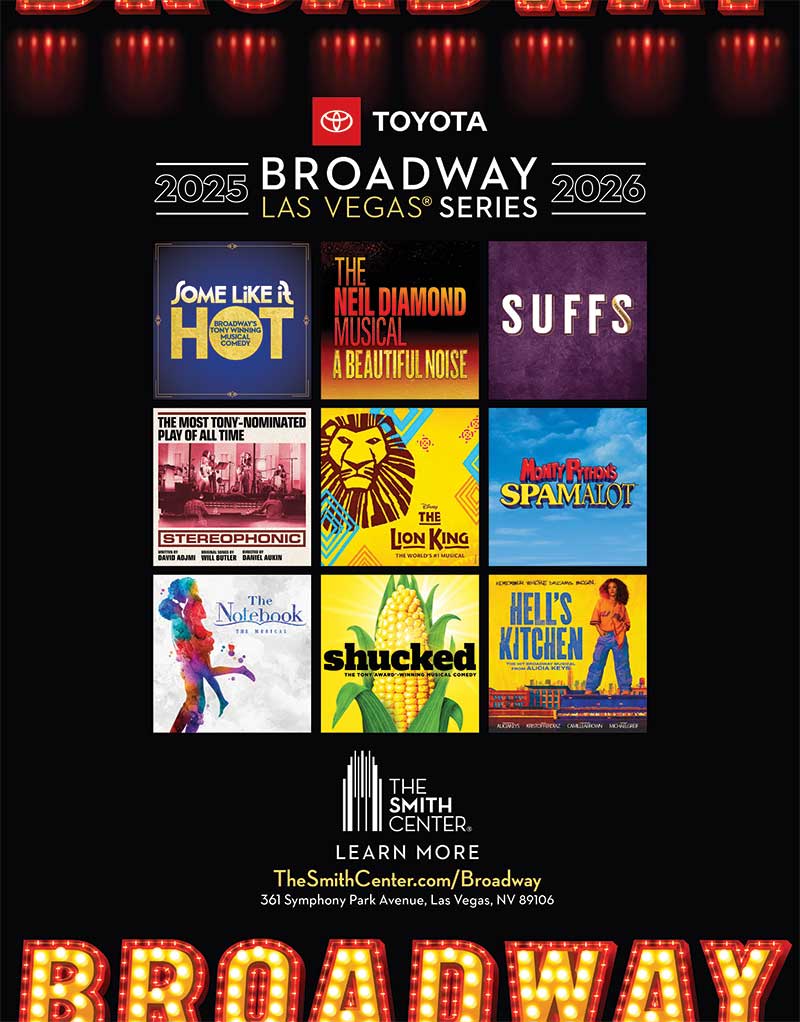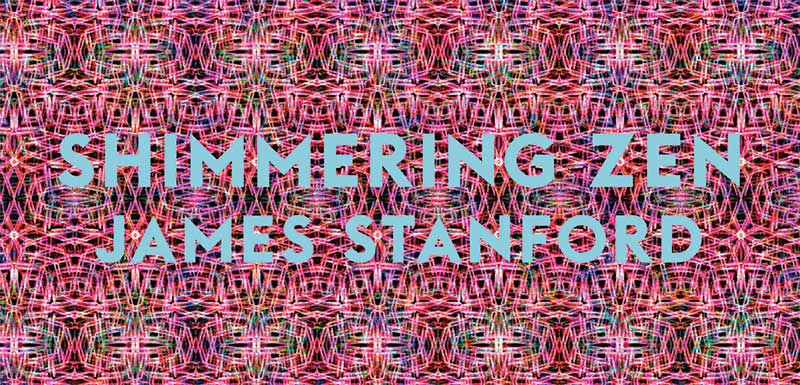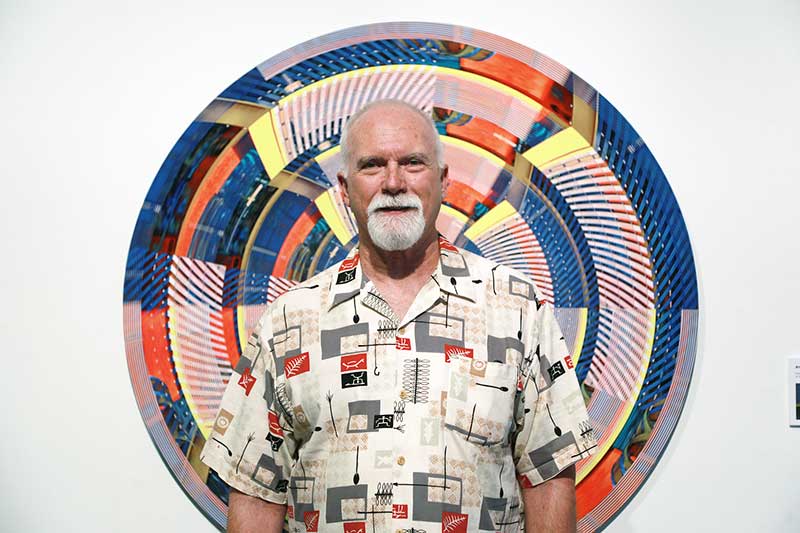
Photo of James Stanford by Checko Salgado
James Stanford: An Artist Shines in the Desert
BY KENDALL HARDIN
Not many Las Vegas artists have their own Wikipedia page, but James Stanford’s entry contains a heap of accolades and tributes spanning five decades.
His vitae praises not only his accomplishments as a visual artist, photographer, digital designer, and technical illustrator but also underscores his pioneering role as a leader, teacher, curator, publisher, and entrepreneur in the Las Vegas cultural community from its founding to today.
Jim Stanford is a native son of vintage Las Vegas, born 73 years ago in the city’s only hospital when the population approached 38,000 residents. He grew up in the historic Huntridge District, the son of Bernice and Harvey Stanford, two high school teachers who resettled here in 1936 from Texas. In 1944, his father achieved local celebrity sainthood for coaching the undefeated Las Vegas High School “Dream Team” to the state championship title, outplaying the big teams that traditionally dominated.
DISCOVERING THE ARTIST’S PATH
Jim showed early artistic talent with an exceptional ability to draw, but it wasn’t until he traveled abroad that he encountered a rare transformative experience that thrust him onto the path of an artist.
“I was 20, and the Prado Museum in Madrid was the first museum I ever visited,” explained Jim. Standing before Flemish painter, Rogier van der Weyden’s monumental Northern Renaissance masterpiece, Descent from the Cross (1435), Jim experienced an episode of shock known as the Stendhal Syndrome, which produces an intense psychosomatic reaction.
“I fainted in front of the painting and was unconscious for 15 minutes. When I awakened, I had this uncanny insight into the painting techniques of the old masters that confirmed my devotion to making art. It was a kind of artistic conversion that made me feel whole again.”
In the first graduating class from UNLV’s art department in 1971, Jim received his Bachelor’s of Fine Arts degree in painting. Two years later, he followed by earning a Master of Fine Arts degree from the University of Washington in Seattle two years later. When he returned to his Mojave Desert homeland—then more of a “cultural desert”—he faced a shortage of galleries and exhibition spaces.
“After graduation, I literally dug ditches and dealt blackjack until I established myself as an instructor in UNLV’s Fine Arts Department in 1978,” Jim recalled. “To survive, I produced technical illustrations for EG&G – Edgerton, Germeshausen, and Grier (Doc Edgerton’s company), which performed high-speed photography for above-ground atomic bomb explosions.
“When I set up my graphic design business, I had to leave all my traditional skills behind and become an early adapter of computer design and digital photography. At first, I was terrified of the digital age, but I soon recognized how this ‘tsunami of technology’ opened up a whole new world for me as an artist. The rewards have been amazing!”
PROJECTING A NEW CREATIVE FORCE
Recognized as a trailblazer of the Las Vegas arts community, Jim served the City as Chairman of the Las Vegas Arts Commission from 1999 to 2001, at which time he created the Downtown Las Vegas “Lightscapes” installation, cited by Art in America as one of 20 leading-edge public art projects of its time.
He also served three years as President of the Las Vegas Contemporary Arts Collective (CAC), later known as the Contemporary Arts Center. He established its second location on Charleston Boulevard, where he curated numerous exhibits and oversaw the organization’s day-to-day operations.
In 1998, Jim co-founded the Las Vegas-based Smallworks Gallery. Seven years later, he created Smallworks Press, a publishing company specializing in arts and culture publications, which secured international distribution through Midpoint in 2018 and later with IPG (Independent Publishers Group).
Smallworks Press has received critical acclaim for many of its publications, including such gems as Street Art Las Vegas by William Shea and Patrick Lai, Motel Vegas by Fred Sigman, and Compass of the Ephemeral: Aerial Photography of Black Rock City through the Lens of Will Rogers.
In 2007, he participated in the Mayor’s Roundtable to explore the future of the Downtown Las Vegas Arts District and First Friday events. Jim’s artwork continued to be represented by the Trifecta Gallery in the Arts Factory until the gallery’s closing in 2015.
ZEN MEETS THE DIGITAL AGE
Jim was introduced to Seon Buddhism (Korean Zen) as a young man, providing deep spiritual inspiration and discipline for both his meditative practice and artwork. In the last decade, Jim received wide exhibition and critical acclaim for his Indra’s Jewels series. He was deeply moved by the Jewelled Net of Indra, a metaphoric image in Hau-Yen Buddhism where everyone and everything is interrelated in the universe and infinitely reflected off each other as wondrous shimmering jewels.
Based on such paradoxical Zen principles as the “unity of polarity,” Jim uses digital technology to transform photomontages of Las Vegas’ mid-century signage, neon, and architecture into intricate, kaleidoscopic patterns superimposed on large circular discs. These exquisite “modern mandalas” are breathtaking. They can be enjoyed for their aesthetic beauty alone or at a much deeper level, where the “magic circle” becomes a spiritual representation of the cosmic universe and a meditative guide on the path to enlightenment.
In 2017, Jim exhibited the Indra’s Jewels series in his Shimmering Zen exhibition at Asia Art in London. At the same time, he released a large companion book by the same title, itself an objet d’art, exquisitely published with full-bleed details of over 240 mandala creations—a tour de force of visual dynamism.
The text of this art tome is equally joyful and full of wonder. One can take a “walkabout” with the artist by following his conversation with Laura Henkel . . . reminiscing about a primordial desert landscape that welcomed a young city dotted with gambling, Nellis Air Force Base and the Atomic Testing Site in the outback. His tales of coming of age in the Mojave demonstrate that vintage Vegas is in his DNA … and deeply reflected in his art.

Shimmering Zen book released in 2017.
Photo by David Jensen (UK)
Shimmering Zen Concertina (PDF Download)
Jim teamed up with Las Vegas fashion designer David Tupaz to create diaphanous scarves and fabrics printed with Shimmering Zen designs for Tupaz’s 2018 fashion showing at New York’s prestigious Fashion Week. A local fashion extravaganza followed at the Sahara West Library to complement Jim’s exhibition of select Shimmering Zen pieces on view in the Studio Gallery.
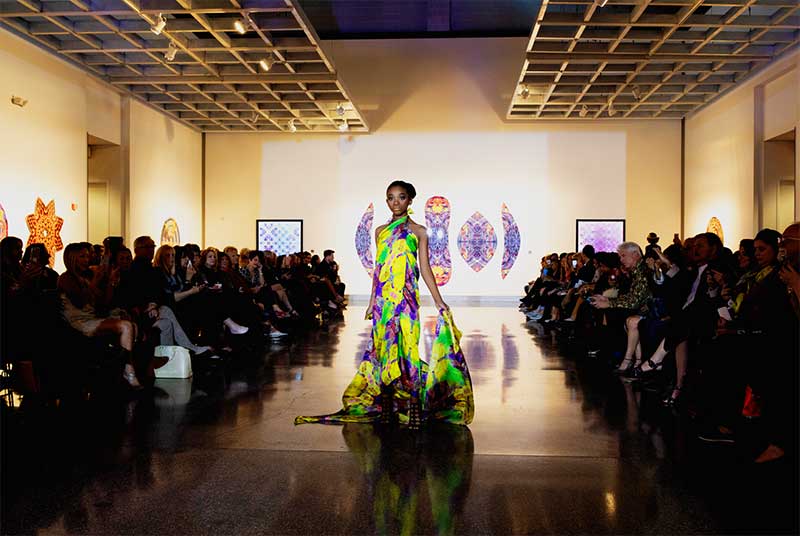
Shimmering Zen Fabrics and Scarves Animate the Runway
Photo by Checko Salgado
RE-IMAGINING THE PAST
In 2018, Jim designed a monumental mural to commemorate the beloved statue of the Blue Angel that adorned the rooftop of Blue Angel Motel (Fremont and Charleston streets) for over six decades, until “Our Lady of Las Vegas” was taken down in 2017 to be refurbished. The original 16-foot statue was created by Betty Willis, who also designed the iconic “Welcome to Fabulous Las Vegas” sign.
A Phalanx of Angels Ascending was commissioned by Alison Chambers, the building’s owner at 705 North Las Vegas Boulevard. The mural spans over 2,000 square feet, wrapping around all three sides of the building. With a touch of classic wit, one blue angel appears on the half shell, a nod to Sandro Botticelli’s celebrated Birth of Venus. Multiple other angels rocket to heaven aided by the thrust of jet engines.
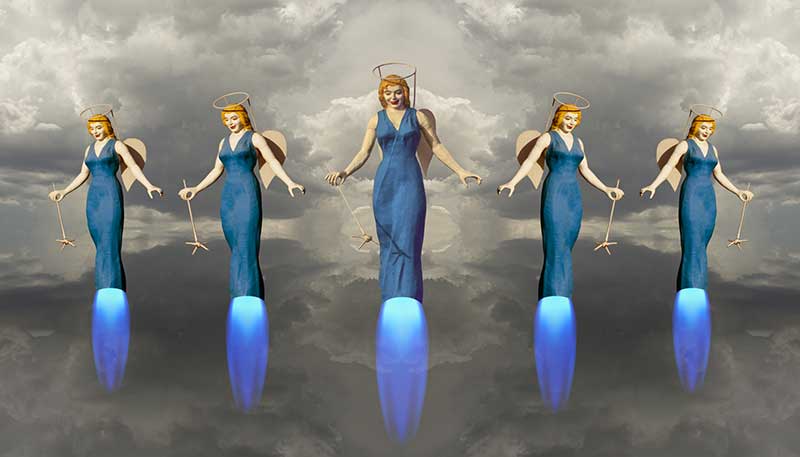
A Phalanx of Angels Ascending Print by James Stanford
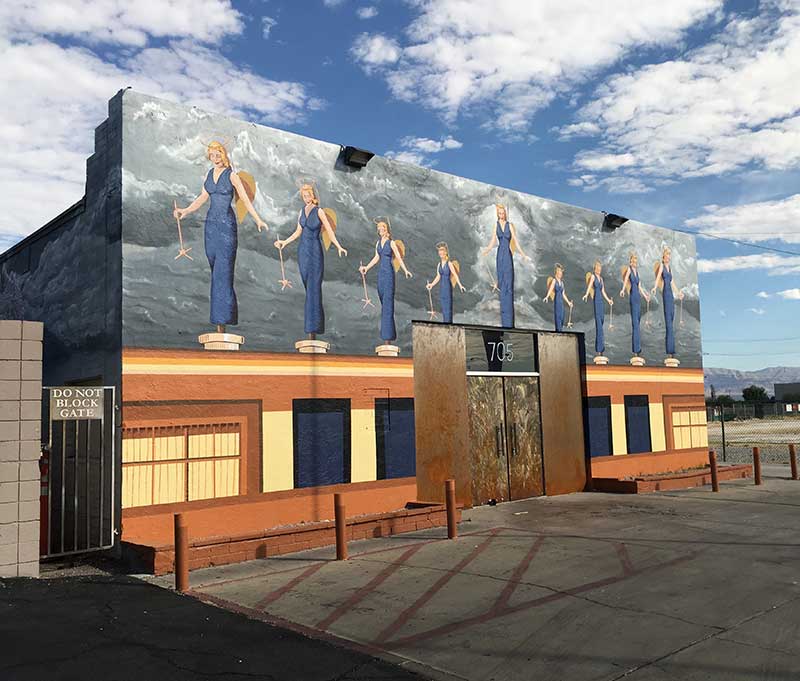
Mural Celebrating “Our Lady of Las Vegas.” Photo by Laura Henkel
Jim’s latest large-scale design in 2019, entitled From the Land Beyond Beyond, spans that south wall of the Reed Whipple Building across the street from the Neon Museum Boneyard. The 154-foot mural pays tribute to two early Las Vegas landmarks – the Stardust Resort & Casino (imploded in 2007) and the Dunes Hotel and Casino (closed in 1993 to make way for the Bellagio that reopened in 1998).
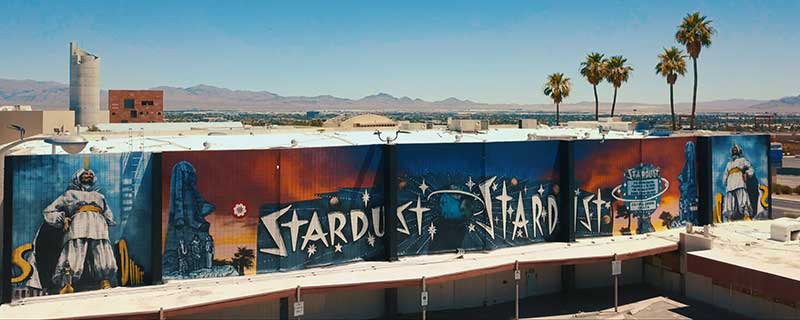
From the Land Beyond Beyond Mural. Photo by Kin Lui
The images include two colossal lava rock Moai, which stood guard outside the Stardust’s Aku Aku Polynesian Restaurant and Tiki Bar. Also depicted is the giant Sultan from the Dunes, including the tiny harem darling perched on the toe of his pointed slipper. Such fabulous kitsch! No longer a memory of the past, these life-size images are granted new life on downtown walls.
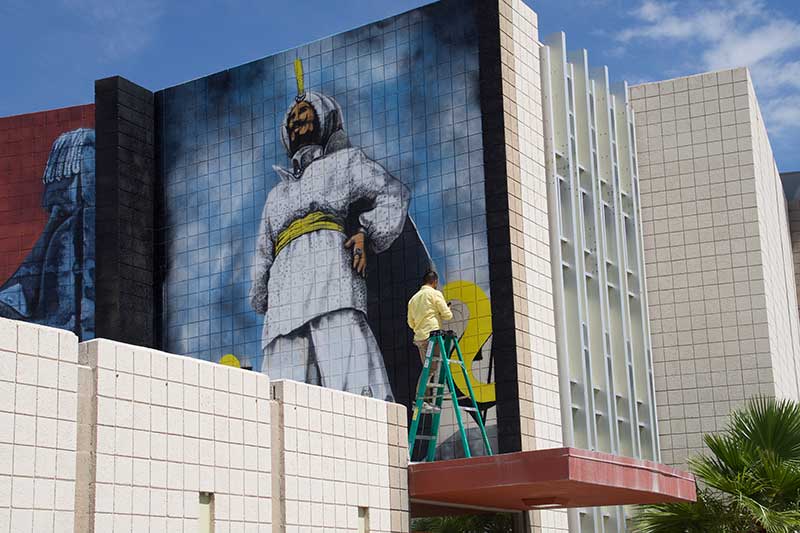
Detail of the Dunes Sultan on the Reed Whipple Building.
Photo by James Stanford
PUSHING THE ENVELOPE
Jim has mastered a number of complex printing methods for his mandalas, depending on whether they involve single or multiple layers—employing such processes as light lasers, silver-halide photographic paper, aluminum metal plates, and dye-sublimation techniques.
If the image involves two or more layers, then a meticulous lenticular process is used. A lenticular print positions alternating strips of images on the back of a transparent sheet composed of a series of curved ridges (lenticules). When light passes through the lenticules, the images “flip” one to another through refraction and magnification to produce a single complete image. As the viewer shifts his line of sight, the image vibrates and shimmers.
I got lost peering into his Shimmering Zen works to ferret out images from Old Vegas that no longer exist: the Horseshoe Club, Sassy Sally’s, Stardust, Coin Castle, and Aladdin, to name but a few. For me, his work offers up a clever, witty conceit of composition that renders pure joy. The old is reincarnated in a whole new form of exquisite beauty. Is this a form of contemplation?
Put a child in front of a lenticular piece that is back-lit, and the “dance of life” between viewer and work is instantaneous: head bobs, arms wave, and giggles emerge. The response to Jim’s work is profound – whether from a Buddhist monk, an art lover, or a young child.
If it’s true that talent does an old thing well, but genius makes an old thing new, then Jim has found his voice and realized his passion.
I’d say this Las Vegas homeboy didn’t just make good; I’d say James Stanford, the artist hit the jackpot.
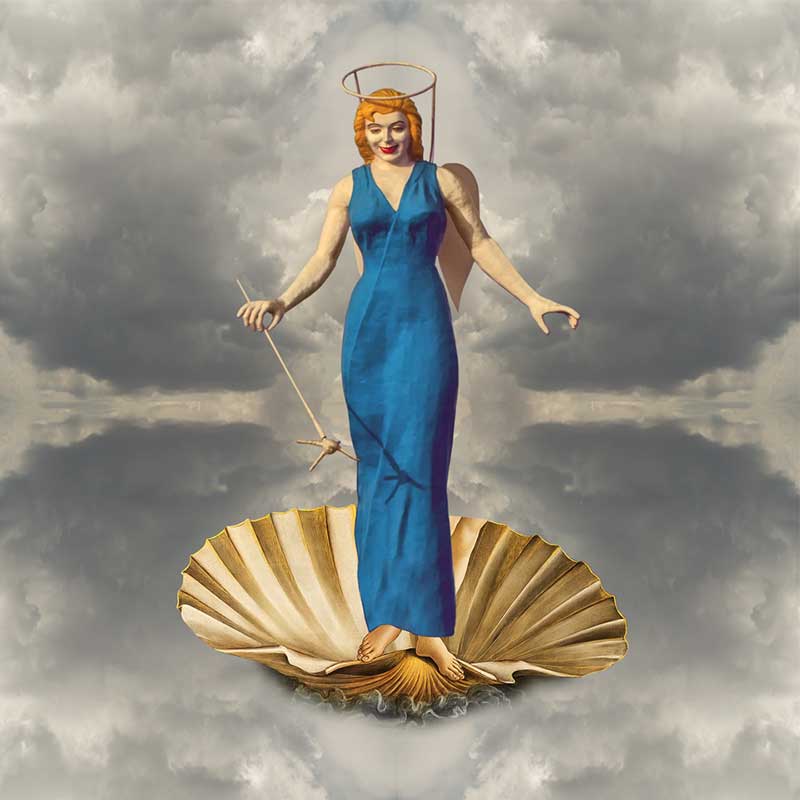
Blue Angel on the Half Shell
Print by James Stanford
Note: James Stanford’s Private Studio + Gallery is located in the historical Scotch Eighties in Downtown Las Vegas (available by appointment).
Visit jamesstanfordart.com for more details on the artist’s background, his portfolio, and a list of exhibitions, as well as an array of art and merchandise for sale.
Stanford’s 48” back-lit lenticular portal “Ing-Ing” will reside in the permanent collection of the Neon Museum, where readers may also purchase his book Shimmering Zen, scarves, 12” square aluminum prints, and T-shirts imprinted with mural images of the Blue Angel, “Our Lady of Las Vegas.”
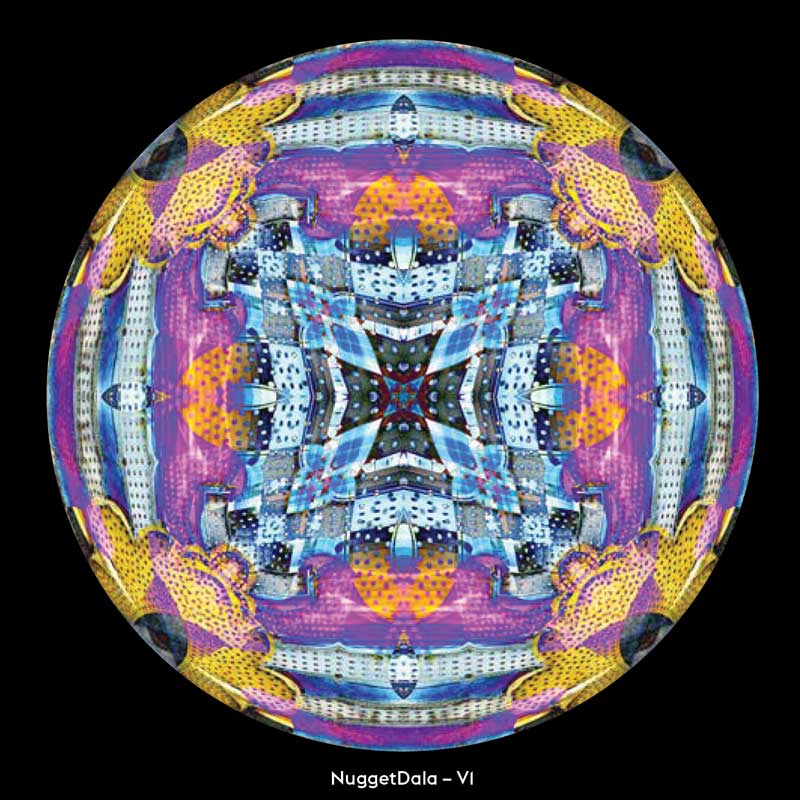
A mandala is a spiritual and ritualistic symbol that takes you to another realm, the realm of the cosmos. It can be any shape, but most conventional images are circular.
To enjoy a mandala, follow this advice from James Stanford: “If you’ve never viewed a mandala before, don’t let that stop you. You just open your mind to what’s there and follow it. Follow your consciousness and see what happens. Put aside your concerns that you’re not doing it correctly and just get into it. That’s about my only advice: follow your breath and allow your vision and your breath to hook up so that your eyes are floating on your breath.”


